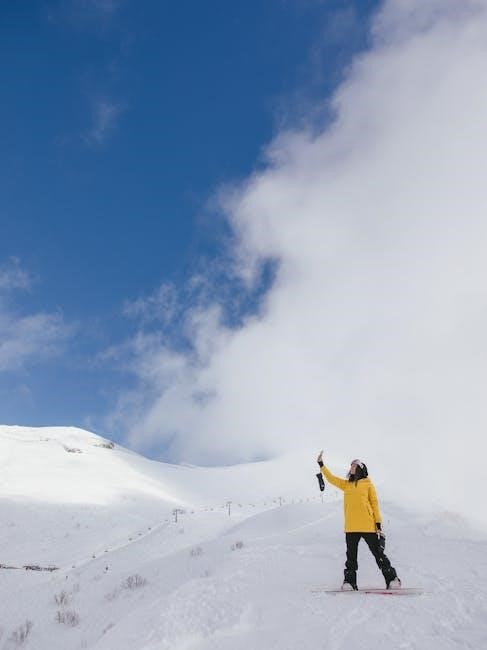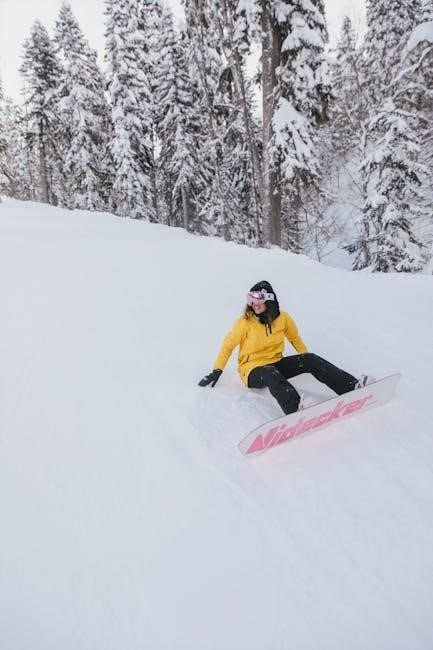Choosing the right women’s snowboard size is crucial for optimal performance and comfort. Factors like weight, height, and riding style influence the ideal board length. This guide provides a structured approach to selecting the perfect snowboard, ensuring a better experience on the slopes.
Understanding the Importance of Proper Snowboard Sizing
Proper snowboard sizing is essential for maximizing performance, control, and overall enjoyment on the slopes. A board that is too long or too short can hinder maneuverability and responsiveness, making it difficult to navigate various terrains. Incorrect sizing may also lead to fatigue or discomfort, impacting your riding experience. Conversely, a well-sized snowboard ensures better balance, easier turning, and enhanced stability, allowing you to ride confidently. Whether you’re carving through groomed trails or exploring backcountry, the right size ensures optimal performance. Key factors such as weight, height, and riding style play a significant role in determining the ideal board length. Understanding these principles helps you make informed decisions for a more enjoyable and efficient ride.

Key Factors Influencing Snowboard Size
Weight, height, and shoe size are primary factors influencing snowboard size. They help determine the ideal board length for optimal performance and comfort on the slopes.
Weight, Height, and Shoe Size
Weight, height, and shoe size are essential for determining the right snowboard size. A rider’s weight directly impacts the board’s responsiveness and floatation, while height and shoe size influence stance and control. Typically, snowboard size charts provide a range based on these metrics. For women, a board length of 135-155 cm is common, depending on weight ranges from 80-160 lbs. Shoe size also plays a role in binding compatibility, ensuring a comfortable fit. By aligning these factors, riders can achieve better balance, maneuverability, and overall performance on the mountain.
Riding Style and Ability Level
Riding style and ability level significantly impact snowboard size selection. Beginners often benefit from shorter boards for easier control and maneuverability, while advanced riders may prefer longer boards for stability at higher speeds. Freestyle riders typically opt for shorter lengths to enhance agility and trick performance. In contrast, all-mountain or powder riders often choose longer boards for better floatation in deep snow. Ability level also plays a role, as less experienced riders may find shorter boards more forgiving. Ultimately, aligning the board length with your riding style ensures a more enjoyable and responsive experience on the mountain.

How to Choose the Right Snowboard Length
Start with your weight and height to determine the recommended length range. Adjust based on riding style and ability level for optimal performance and comfort on the slopes.
Size Charts for Women’s Snowboards
Snowboard size charts for women typically correlate weight, height, and shoe size to board length. For example, a rider weighing 100-130 lbs (45-59 kg) may prefer a 138-143 cm snowboard. Charts often provide a range, allowing adjustments based on personal preference and riding style. Shoe size can also influence stance width, ensuring comfort and control. These charts serve as a starting point, but individual factors like ability level and terrain preferences may require further customization. Always consult the manufacturer’s specific guidelines, as sizing can vary between brands. Proper fit is key to maximizing performance and enjoyment on the slopes.
When to Size Up or Down
Adjusting your snowboard size depends on specific riding conditions and personal preferences. For powder, consider sizing up for better float, while freestyle riders may prefer a shorter board for easier maneuvers. Weight and height recommendations are a starting point, but terrain and ability level also play a role. If you’re within two weight ranges, choose based on your riding style—shorter for agility and longer for stability. Test different sizes if possible, as fit can vary between brands. Proper sizing ensures optimal control and performance, making your snowboarding experience more enjoyable and effective. Always prioritize how the board feels during use.

Understanding Snowboard Shape and Style
Snowboard shapes vary to suit different riding preferences. All-mountain boards offer versatility, freestyle boards enable tricks, and powder boards enhance float in deep snow conditions.
Difference Between All-Mountain, Freestyle, and Powder Boards
All-mountain snowboards are versatile, catering to various terrains, from groomed trails to backcountry. Freestyle boards are shorter and softer, ideal for tricks and park riding. Powder boards are longer with a wider nose for floatation in deep snow.
- All-mountain boards balance performance and adaptability.
- Freestyle boards prioritize maneuverability and playfulness.
- Powder boards excel in deep snow conditions.
Choosing the right style depends on your riding preferences and the terrain you frequent most.

Using a Snowboard Size Chart Effectively
Refer to weight, height, and riding style to find your ideal size. Use the chart to narrow down options, then choose based on maneuverability or floatation needs.
Interpreting Weight and Height Recommendations
Weight and height are critical factors in determining the ideal snowboard size. Charts typically provide a range, such as 80-120 lbs for a 135-140cm board, helping balance stability and maneuverability. Height aligns with board length for proper stance and control. Riders should consider their ability level; lighter weights may prefer shorter boards for easier handling, while heavier individuals might opt for longer boards for better floatation. Adjustments may be needed based on riding style, ensuring the board performs optimally in preferred conditions. Always cross-reference weight and height with brand-specific charts, as sizing can vary slightly between manufacturers. Proper fit enhances performance and comfort.

Brand-Specific Sizing Variations
Different brands use unique sizing methods, leading to variations in fit and recommendations. Always consult the specific brand’s size chart for accurate guidance and optimal performance.
How Different Brands Size Their Snowboards
Brands vary in how they size snowboards, often tailoring to specific riding styles or body types. Some may offer shorter lengths for freestyle, while others focus on stability with longer boards. Weight and height charts differ slightly between brands, so it’s essential to check each brand’s guidelines. For example, Burton and Rossignol might recommend different sizes based on the same weight and height. Additionally, some brands use unisex sizing with women’s-specific adjustments, ensuring a better fit. Always refer to the brand’s official size chart for precise recommendations to match your needs and preferences.

Finding the Perfect Fit
Finding the perfect fit involves ensuring your snowboard and bindings work harmoniously, providing both comfort and responsiveness. Proper sizing enhances control and performance, making every ride enjoyable.
Importance of Binding Compatibility
Ensuring binding compatibility with your snowboard is essential for optimal performance and safety. Bindings come in different sizes, corresponding to boot sizes, and must align with your snowboard’s width. Properly fitted bindings enhance control, stability, and responsiveness, allowing for better maneuverability. Compatibility also prevents issues like poor edge hold or uneven weight distribution. While size charts provide guidance, actual fit can vary between brands. Always check compatibility when purchasing, as mismatched setups can hinder performance and comfort. A well-matched binding and snowboard combination ensures a smoother, more enjoyable riding experience, making it a critical factor in your snowboarding setup.



